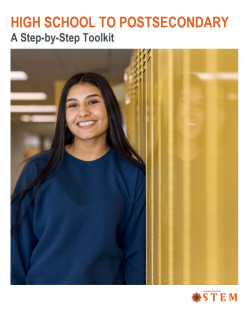High School to Postsecondary Toolkit
Toolkit Available Now

The High School to Postsecondary Toolkit is available for download (updated March 2024).
About the Toolkit
Created with partners across Washington state, this toolkit documents findings from a 2020-21 study of disparities in dual credit participation at Eisenhower High School. The toolkit—which includes practical examples, templates, instructions for data access, and more—can be used as a guide to begin similar studies at your own school.
The Eisenhower study looked at course and outcome data and student/staff interviews and surveys to identify disparities in dual credit participation. The Career and College Readiness Toolkit, a scalable approach to improving equity in dual credit programs, was created from lessons learned during the study.
To learn more about the Eisenhower study, you can read our posts about the partnership and project or the students’ perspective.
Dual credit programs allow students to earn high school and college credit simultaneously. We know that dual credit course enrollment is beneficial because:
- Dual credit participation reduces the time (and money) required to complete a 2-year or 4-year degree.
- Dual credit experiences help students build a college-going identity and confidence.
- Dual credit enrollment strongly correlates with a higher likelihood of enrolling in postsecondary education.
Findings from the Study at Eisenhower High School
The Eisenhower team began this project in 2020 because they had hunches about disparities in dual credit participation, were unsure of who was most impacted, and had support from the Principal and Superintendent to focus on issues of equity. Read the full technical report for more detail. The data, surveys, and interviews highlighted some tangible issues for Eisenhower High School:
- By looking across high school enrollment patterns and postsecondary data, it was clear that Eisenhower students enrolled in dual credit—epespecially Advanced Placement and College in the High School—were matriculating and completing their postsecondary pathways at a greater rate than students not taking any dual credit coursework.
- Significant barriers existed for Latinx male population in accessing, enrolling in, and completing dual credit coursework.
- Teaching staff are the number one source for information about dual credit for students (not counselors), though 50% of teaching staff reported not being comfortable providing dual credit guidance.
- Older students and peers were another significant source of information about dual credit.
A Path Forward
The High School to Postsecondary Toolkit, created as an integral part of the study at Eisenhower High School, highlights some of the strategies and corresponding technical support Washington STEM will use to build capacity with our partners as we help them to make informed local changes to dual credit programs across the state. We will continue to leverage this work to advocate for statewide policies that increase equitable access to, enrollment in, and completion of dual credit.
Read more about this College and Career Readiness project at Eisenhower High School in our feature “Developing Equitable Dual Credit Experiences”.
Learn more about student Dual Credit experiences at Eisenhower High School in our feature “Listening to Student Voice: Improving Dual Credit Programs”.